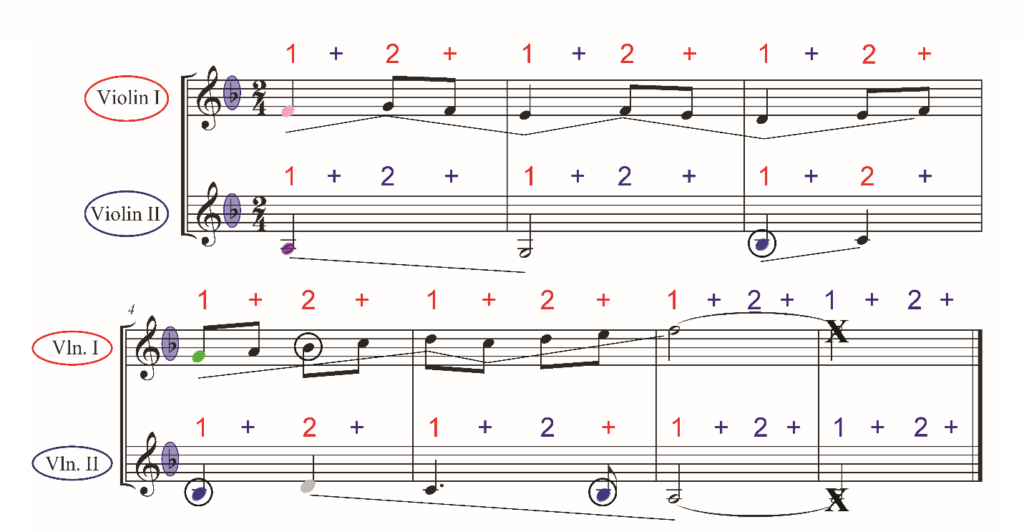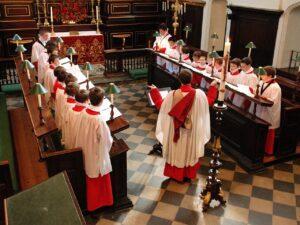Estimated reading time 3 minutes
Table of Contents
Introduction
What are sharps and flats, where did they come from, and how can we make it easier to read them? Read more to learn how to color code key signatures.
- Reading music would be much easier if sheet music stuck to just the natural notes (i.e., the white keys on the piano).
- However, sheet music doesn’t, and as a result many students become frustrated when reading sharps and flats.
- The key signature (the sharps and flats to the left side of the staff) just make things harder.
This article uses technical musical terms. For definitions, see the Glossary at the end of the post.

A Brief History of Sharps and Flats
Mobile users: for best results reading the examples, tilt your screen 90o to the right.

Originally, the keyboard had only the white keys (the naturals). Later Bb (B flat) got added to the mix. These notes made up the medieval gamut.
- Then, singers started to sing the equivalent of the remaining sharps and flats from the modern keyboard.
- However, the medieval theorists felt that these notes did not exist, so they labeled them musica ficta. This meant “fictional music.”
- The medieval theorists did not have special signs for the musica ficta notes, because of how they viewed them.
- Moreover, they called the white keys on the keyboard the naturals and the black keys accidentals.
- They did this because they thought the black keys were accidents.
After a few hundred years, signs for the accidentals began to appear.
- The sharp sign tells a pianist to play the next key to the right.
- Therefore, C# (C sharp) sits to the right of the C key on the piano. Likewise, Bb sits to the left of the B key.
- Despite having similar names, the accidentals remain distinct notes from the naturals.
- The accidentals worked as a patchwork fix for the notation that existed in the medieval period.
- Specifically, they expanded the number of pitches that composers could notate.
Today, we live with the aftermath of the decision to use sharps and flats rather than start over from scratch. In other words, the accidentals make note reading much harder than creating distinct labels (with their own places on the staff) would have.
In any case, students respond well to color coding. I suggest teaching accidentals in this order:
- Describe how the accidentals work.
- Explain where the accidentals came from to give students the big picture.
- Color code the key signature.
- Circle the accidentals to help the students play the music.
How to Color Code Key Signatures
Color Coding the Key Signature

You can color code the key signature by taking a crayon or colored pencil and coloring right on the sheet music. Parents and private music teachers may find this the easiest choice.
- For classroom teachers making materials to handout or email to students, they will require both an art and a music notation program.
- Finale Music Notation software will color the notes for you. (For more colorizing notation software options, click here.)
However, Finale doesn’t color code the key signatures. Therefore, you need to:
- Export your music examples from your notation software as a TIFF, JPG, or PNG file.
- Import the file into an art program, such as Adobe Illustrator or Corel Draw.
- Use a transparent effect on a colored object over the key signature so that the sharp or flat shows through. You can usually create the object with a shape tool.
- Or you can use the Maestro font (or another music font) to recreate the sharps and flats over an opaque-colored object. You can usually find the font in the text tool.
In the example above, F# gets colored pink and C# gets colored orange. (Here I used a transparent effect.) In the example below, I color coded the Bb blue. This keeps the sharps and flats consistent with how we color coded the notes.

Circling the Accidentals
Even after you have color coded the key signature, most students will need you to circle the accidentals in the score.
- This reminds the students that a note gets played as an accidental.
- If old enough, have the students circle the accidentals themselves.
Some students will need the circled accidentals color coded.
- If the student has graduated from the colors, or uses contour lines, you may not need to color the circled notes. It depends on the student.
- For an example of contour lines, see the slanted lines in the next example. More on these in later posts.
However, ledger lines are harder to read, so most students will need the ledger line accidentals colored.
- The example below has all of the Bbs circled.
- In addition, I have colored all of the ledger line Bbs blue.
- However, I did not color the Bbs on the body of the staff.
What you do hinges on what the student needs.

Concluding Thoughts to Color Coding Key Signatures
If the staff had been carefully designed rather than having grown organically, students might not get so frustrated trying to read music.
- Nevertheless, teachers need to teach the system we have.
- As a result, figuring out how to keep students from getting confused remains job one.
Color coding is an important strategy in the teacher’s multisensory toolbox.
- All students benefit from multisensory teaching.
- However, ADD, LD, ASD, and special needs students need it most of all.
© 2021 Geoffrey Keith
Join me for in-person or online lessons today!
Glossary
Choir Meaning & Examples with Videos, Pictures, & Soundtracks
Do you want to know the meaning of the word choir? In this post, you’ll learn how a choir works, including video and soundtrack examples of choir and chorus music. Keep reading “Choir Meaning & Examples with Videos, Pictures, & Soundtracks” to learn more. Estimated reading time 3 minutes.
Read MoreHow Do You Sing Eastern European Vocal Harmony in 2nds by Ear?
Have you ever wondered how Eastern European vocalists sing polyphony in parallel 2nds? Do you want to know how world music works? Understanding world music involves stepping outside your own perspective and seeing from the world musician’s point of view instead. Click to answer the question, “How do you sing Eastern European vocal harmony in 2nds by ear?” Estimated reading time 3 minutes.
Read MoreWhat Is the Precise Meaning of Scaffolding in Teaching?
“What is the precise meaning of scaffolding in teaching?” Scaffolding is an effective teaching method that’s designed to help students in the early phases of learning. It helps them close the distance between what they can do now and where they need to be in the future. Keep reading to learn more. Estimated reading time 2 minutes.
Read MoreSinging with the Kodaly Rhythmic Syllables
Do you struggle with singing accurate rhythm? This post expands your rhythmic flexibility, which makes singing melodies more fun. Click to learn how to sing with the Kodály rhythmic syllables. Estimated reading time 3 minutes.
Read More




